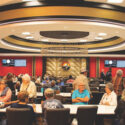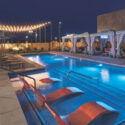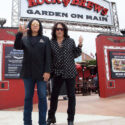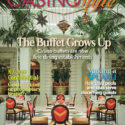
It has become commonly recognized by developers and restaurateurs that customers are seeking more than just great food when they sit down for a meal in a nice restaurant. They want an experience. What this exactly means is a question that has only recently become the subject of study by thought leaders within the hospitality industry.
As we examine the key components of a dining experience, design emerges again and again as a critically important piece of the puzzle. Executives refer to the importance of design within the context of congruency, the bridge between the story they want to tell and the brand identity they want to reinforce. Managers refer to design’s impact on staff efficiency and their ability to turn more tables each night. Customers, particularly within an integrated resort, will often shop the look of a restaurant before thinking about viewing a menu.
Increasingly, design is becoming credited as one of the most important, and least studied, attributes in why consumers choose one restaurant over another. From an increasingly visual universe of online and social media reviews, where consumers share commentary and imagery, a restaurant’s design is moving from background to foreground in its influence within the overall experiential palate.
Academic researchers are recognizing the importance of design, particularly in creating desired ambiances within fine dining restaurants. More and more, it is becoming accepted that physical environments create emotional responses in individuals, which in turn elicit a desire to further explore or completely avoid. This concept is further elaborated upon via the postulation of “servicescapes” that emphasize the critical importance of providing attractive environments for inducing customer satisfaction and loyalty over time.
Accordingly, a positive response to a “servicescape” is expected to result in positive beliefs and feelings toward the establishment, its people and its offerings.
Media covering the industry is also taking notice, as evidenced when Elite Traveler revealed its World’s Top 100 Restaurants of 2014. The list’s 16 new entrants, voted on by readers of the luxury lifestyle publication, lauded the association with a famous architect and designer as much as a posh location, exotic cuisine or celebrity chef affiliation.
Consumers feel more empowered than ever to evaluate what in the past may have been viewed as the unsung ingredients of a dining experience. Emboldened by a sense of expertise that popular television shows such as Chopped, Beat Bobby Flay and Restaurant Startup have given them, the general public has a raised antenna to every aspect of the restaurant experience today. Their expectations are high. And they’re not afraid to let the world know—through Yelp, Instagram and Twitter—when they have been disappointed.
Because of this, we must study consumers like never before and put our learnings to work at the onset of our development process.
Why Study Guest Psyche?
In the hospitality industry, deep thought about the psychological and emotional drivers of choice on consumer decision-making is quite rare. Hoteliers and restaurateurs have historically developed properties as much for their own egos as they have for a perceived, or hoped-for, demand.
With consumer spending in restaurants up dramatically and consistently over the past four decades, competition has also greatly increased. That reality has placed incredible pressure on developers to conceive new concepts, quickly, which will both differentiate and resonate with a fickle public. From the heights of economic prosperity to the depths of financial depression, the hospitality industry—as a whole—has been slow to embrace a researched approach to development.
In global destination markets like Las Vegas, a “build it and they will come” approach dominated the first two thirds of the town’s “cowboy-to-gangster-to-MBA” progression.
Perhaps another rationale for steering clear of a science-based path toward understanding behavior has to do with a longstanding misconception of what “research” is and how it should be applied toward understanding customer psyches. Justification for this internal bias may be that “market research” is viewed as a sign of executive weakness or that there is a fear of delaying tight schedules or derailing projects entirely if consumers don’t respond “the way we want” to our ideas, sketches and animations.
Steve Jobs: Research Foe?
Many executives around the world would nod their heads in agreement if they happened to come across the Steve Jobs quote, “Customers don’t know what they want until we’ve shown them,” or a quote Jobs apparently liked from Henry Ford, “If I’d asked customers what they wanted, they would have told me, ‘a faster horse!’”
Jobs is absolutely correct in his statement, as is Ford; but neither makes a convincing case for not conducting market research. Rather, both highlight the misperception many have as to what consumer research is—namely, asking people directly what they want.
To actually understand what consumers want is an egoless exercise in immersion, venturing as deep as possible into what it’s like to be them—at home, at work and at play.
This approach, done correctly, yields valuable insights that misguided methodologies would have missed or, at best, misconstrued. These insights, in turn, spark actionable ideas—in the minds of artists and executives—that are rooted in something viable.
Within this capacity, Jobs was an exceptional “researcher” of human behavior. In this context, his brilliance was that he understood, before the opportunity developed, that everyday people wanted to use computers, yet the frustration in their complexity was an overwhelming barrier for the non-technically inclined. His focus on a “lite” version of a computer, that was simple and stylish, was a direct result of insights gleaned from observing consumer experiences with what was in the marketplace.
No one could have told Jobs to make an iPod, iPhone or an iPad either—but by stepping into his customer’s shoes and understanding their emotional and psychological desires, Jobs was able to anticipate mass-market trends, because they were rooted in behavior he could validate with not only his deep imagination but also with his sharp eyes and ears.
The link is not only ironic, it is also perceptible. Court records from a recent lawsuit between Apple and Samsung have resulted in much previously confidential information becoming public record. Among the findings: Apple’s investment in market research and its vast user experience teams are likely unparalleled. Jobs didn’t waste time asking consumers directly: “What do you want us to make?” But you can be sure Apple is obsessed with understanding human behavior and that the company uses consumer insights to help drive innovation.
Embracing Consumer Insights
For the restaurant industry, there has never been greater potential. Economic prosperity and discretionary spending have largely recovered from 2008-2009 recession levels. According to the National Restaurant Association, A
mericans today make nearly half of their food purchases away from home. In 1955 it was 25 percent. In the United States, restaurant sales are expected to reach $683 billion in 2014, a $100 billion increase from just four years ago.
The pressure to increase operational efficiencies and turn as many tables per day as possible, without sacrificing customer service, also puts the spotlight on design as a critically important component for a restaurant’s success. As such, understanding the psyche of a hospitality patron has never been more critically important for a business owner.
















